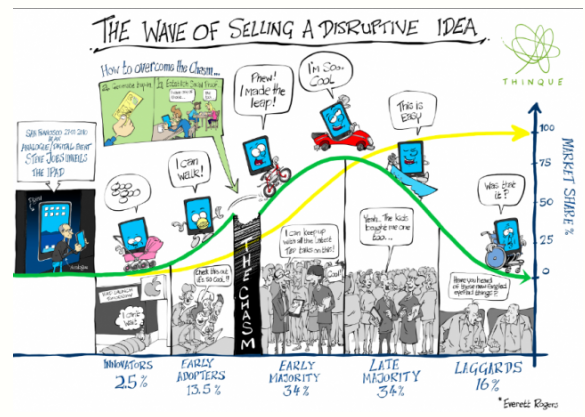How to get Senior Management to commit resources to innovation ? How to secure Senior Management Buy-In ?

Fear and Desire lead to commitment
Getting somebody to commit is a function of two things and two things only: fear and desire. Thomas Hobbes, a philosopher of politics, showed how fear and desire gets people to relinquish a degree of liberty in exchange for collectively-ensured security.
More recently, Daniel Kahneman, a Nobel Prize psychologist, shows that both fear and desire are critical components of the decision-making process. Presenting a specific topic as a threat (a threat to the business, a threat to their products or a threat to their position in the company) elicits a clear reaction, when, in contrast, presenting the same topic as an opportunity elicits only a lackluster reaction. Typically, fear makes it easier to secure commitment from Senior Management.
How should we frame innovation as fear?
The most obvious example of this is a discussion that went on between Andy Grove and Clayton Christensen. Andy Grove, Intel’s former CEO and author of Only The Paranoid Survive read The Innovator’s Dilemma and called up on Clayton Christensen to understand what this meant for Intel. The Innovator’s Dilemma’s main thesis is that companies, engaged in sustaining innovation, end up overshooting performance required by markets, even the highest and most profitable market segment. This creates a vacuum at the low end of the market, which spells as opportunity for new entrants.
New entrants offering a new kind of technology, working with a different set of partners (termed “value network”), operating on a different business model enabling them to make money at lower prices, penetrate the low end of the market, with lower performing products, sold at a lower price. At first, this makes no difference to leading companies, who are happy to exit less profitable market segments, and focus their investments in more profitable market segments. However, over time, the disruptive company improves its products and starts penetrating more profitable market segments as well, and this time, to the expense of leading companies who lose their customers. Indeed, these customers whose needs are over-served are happy to switch to lower performing products sold at lower prices. Over time, once leading companies loose consumers to disruptive companies and go bankrupt or get acquired.
What does this mean for innovation? What does this mean on how to frame innovation as fear?
In fact, the value proposition to create is quite clear: “Mr. Senior Manager: you have two options: innovate or go bankrupt. Here’s why you’ll go bankrupt if you don’t innovate. And here’s how you must innovate, if you want to survive and grow. And here are the resources we need to get started”.
If you can substantiate a value proposition along those lines by referring to example of companies which were drove to bankruptcy because of disruptive companies, then, you’ll elicit fear and you’ll get buy-in from Senior Management. Those are some thoughts on how to sell innovation to Senior Management.
In any case, this is the kind of value proposition that got Andy Grove to hire Clayton Christensen’ and invest in the Celeron processor, a disruptive innovation in the microprocessor business.
Next week, I’ll share additional insights on how to secure buy-in from Senior Management. In the meantime, please feel free to share your experience. How were you able to get Senior Management to commit to allocating resources to innovation?
Further readings:
- For a description of why innovation is key to staying in business, please refer to Clayton Christensen’s The Innovator’s Dilemma. Chapter 2 and 3 are particularly useful. For a summary, please refer to this article.
- For a presentation of Daniel Kahneman’s ideas on the theory of decision-making, please refer to this article.
- For a discussion of why fear makes a good CEO, please refer to Andy Grove’s Only the paranoid survive. Chapter 3 and 4 show why fear is necessary to understand both how business is changing and how these changes may undermine a company’s strategic position.
- For a brief outline of the discussion between Clayton Christensen and Andy Grove, please refer here.
- For a case study of how the iPad was sold to Apple’s Senior Management, please refer here.
You explain the fact that by overshooting performance required by markets, you end up with new innovative entrants which will eventually kill you. Then you conclude that you have to innovate to survive. I disagree with you on this automatic conclusion.
A R&D Director once told me that his company used to watch these new entrants, copy their innovative – but not perfomative – new products, then finish first on the market. “Start second, finish first” is their strategy, helped by the fact that their processes are the best in the market.
Hi Erwan,
Thanks for your comment. I understand that an R&D director informed you that his/her policy was to be first on the market, even though they start developing an innovation second. Is that correct?
My sense is that their case doesn’t really apply to what I’m describing. I talk about industry leaders that effectively start second (at least relative to a new entrant) and launch their innovation second, as well. And it’s because they come in second, sometimes many years after disruptors, that they loose their market preeminence.
Is this relevant to your question?
Thanks !
Guillaume Villon de Benveniste